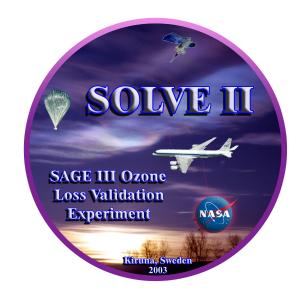The SAGE III Ozone Loss and Validation Experiment (SOLVE II) Mission is an international field campaign designed to acquire correlative data needed to validate the Meteor-3M/Stratospheric Aerosol and Gas Experiment (SAGE) III satellite mission. The field campaign will also acquire correlative measurements with atmospheric chemistry instruments onboard the ADEOS-II and ENVISAT satellite missions to enhance ozone comparison and loss studies utilizing these data sets. Measurements will be made during the Arctic winter using the NASA DC-8 aircraft, balloon platforms, and ground-based instruments. These activities will take place in close collaboration with the European Validation of International Satellites and Study of Ozone Loss (VINTERSOL) campaign, which will include flights of the DLR Falcon and Russian Geophysica M55 aircraft, other balloon platforms and ground-based instruments.
SOLVE II is co-sponsored by NASA's Upper Atmosphere Research Program (UARP), Atmospheric Effects of Aviation Project (AEAP), Atmospheric Chemistry Modeling and Analysis Program (ACMAP), and Earth Observing System (EOS) of NASA's Earth Science Enterprise (ESE). VINTERSOL is sponsored by the European Commission.
Dr. Michael Kurylo and Dr. Phil DeCola are the SOLVE II Program Scientists. Dr. Mark Schoeberl and Dr. Paul Newman are the SOLVE II DC-8 Project Scientists, and Mr. Michael Craig is the SOLVE II Project Manager.
SOLVE II has five basic science objectives. These objectives are:
Measurement of the polar ozone loss rate in early to mid-winter. Relative contributions to low ozone levels from interannual variations in ozone transport and photochemistry will be quantified.
The understanding of polar stratospheric clouds (PSC's). The composition of PSC's and the role they play in the interactions between chlorine and nitrogen reservoir species will be examined.
The study of photochemical processes. The seasonal evolution of chemical processes, in particular the activation and deactivation of chlorine, and their impact on ozone loss will be observed.
The measurement of polar air transport and dynamics. The initial state of polar stratospheric air will be defined and the exchange of this air between the polar vortex and the mid-latitudes will be observed. This will allow a better understanding of the effect of transport on the evolution of the ozone. It will also lead to better predictions of the sensitivity of polar air to jet engine exhaust from current and future aircraft.
SAGE III instrument validation. Ozone, aerosol, water vapor, and NO2 measurements from the DC-8 will be compared to SAGE III instrument measurements to prove the accuracy of satellite observations.


